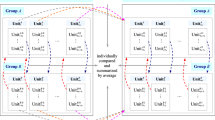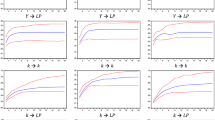Abstract
This paper analyses trends in labour productivity and its underlying determinants in a panel of OECD countries from 1979 to 2002. Data Envelopment Analysis (DEA) is used to estimate a Malmquist measure of multifactor productivity (MFP) change. We decompose the growth in labour productivity into (i) net technological change (ii) input biased technical change (IBTC) (iii) efficiency change and (iv) capital accumulation. We analyse the effect of each of these factors in the transition towards the equilibrium growth paths of both labour productivity and per capita GDP for the OECD countries, controlling for the effects of different policies and institutions. The results indicate that on average gaps in productivity or income levels are narrowing down although there is no evidence to suggest that the entire OECD area comprises a single convergence “club”. Using kernel estimation methods we find that that labour productivity and per capita GDP are settling toward a twin peak (bimodal) distribution. Panel unit root tests over an extended (1960–2001) period provide general support for the convergence hypothesis. Analysis of the contributions of productivity growth within industries and sectoral composition changes show that aggregate productivity change is predominantly driven by ‘net’ within sector effects with very little contribution emerging from sectoral shifts (the ‘in-between’ static or dynamic effects resulting from higher or above average productivity industries gaining employment shares or low productivity industries losing shares).







Similar content being viewed by others
Notes
Note that both TCH and KCH measures are path dependent (i.e., they are generally different dependent upon whether the shift in the frontier is evaluated at the base or current period observation for TCH and whether it is measured along the current- or base-frontier for KCH) unless technological change is Hicks neutral. As Kumar and Russell (2002) emphasise this “arbitrariness is endemic to the basic task of measuring technological change.” We reconcile this problem by using Fisher ideal geometric averages of the two alternative measures of TCH and KCH. This is reflected in (2) as well as in (4) and (6).
Note that the frontier is defined in terms of the ‘best practice’ of the countries in the sample and therefore performance measures are relative. Different MFP productivity measures are likely to obtain in relation to different groupings of countries. We assume that technology is potentially transferable across the sample of countries. Note that each country is compared to the frontier segment with the same input mix. A similar approach but in a parametric setting is adopted by Hultberg et al. (1999). As in Hultberg et al. we allow for the possibility that countries may overtake each other during the transition to their steady state.
New Zealand did not deregulate its labour market until 1992 when the Employment Contracts Act (ECA) came into effect; it has been argued (see, for example, Hansen and Margaritis 1993) that labour market rigidities may have aggravated the adjustment costs during transition from a highly protected to a market driven economy. The ECA was repealed in 1999 and was replaced by a more centralised system of employment relations.
It is likely that Portugal’s labour market, one of the most rigid in the OECD, imposes higher costs of adjustment and therefore exacerbates the problems firms face with adopting or developing new technology (see Scarpetta et al. 2002). In the 1965 to 1998 period the capital to labour ratio in Portugal increased by fivefold while output per worker increased at about half this rate. Contrast this with the case of Ireland where labour productivity outpaced the rate of capital productivity over the same period.
Note that convergence in distribution or σ-convergence provide evidence of convergence but they do not necessarily support the convergence hypothesis as they not address the issue of β-convergence; namely, that lower per capita income (or per unit of labour) countries will catch-up with the rich countries through the process of technology transfer or through higher (marginal) capital productivity. They do not also address the issue of mobility patterns or intra-distribution dynamics (see Bianchi 1997).
The results of standard unit root tests indicate that the individual (log) productivity and output variables are non-stationary I(1) series.
The Levin et al. (2002) panel unit root test rejects the non-stationary null hypothesis for agriculture with a p-value of 0.047. The same test also rejects the null for construction, low tech manufacturing and wholesale and retail trade. The Im et al. (2003) test does not reject the unit root null for financial services (p-value = 0.354).
Abbreviations
- MFP:
-
Multifactor Productivity (Malmquist Index Measure)
- ECH:
-
Efficiency Change
- TCH:
-
Technological Change
- OBTC:
-
Output Biased Technical Change
- IBTC:
-
Input Biased Technical Change
- MTC:
-
Net Magnitude Component of Technical Change
- KCH:
-
Capital Accumulation (Measured by the change in the capital-labour ratio)
- Y:
-
Purchasing Power Parity (PPP) adjusted real GDP
- L:
-
Employment (Annual hours worked)
- s:
-
Saving Rate
- y:
-
Y/L
References
Bernard AB, Jones CI (1996) Productivity across industries and countries: time series theory and evidence. Rev Econ Stat 78:135–146
Bianchi M (1997) Testing for convergence: evidence from non-parametric multimodality tests. J Appl Economet 12:393–409
Caselli F, Coleman WJ II (2006) The world technology frontier. Am Econ Rev (forthcoming)
Caves D, Christensen L, Diewert WE (1982) The economic theory of index numbers and the measurement of input, output and productivity. Econometrica 50:1390–1414
Charnes A, Cooper WW, Rhodes E (1978) Measuring the efficiency of decision making units. Eur J Oper Res 2:429–444
Dowrick S, Nguyen D (1989) OECD comparative economic growth 1950–1985: catch up and convergence. Am Econ Rev 79(5):1010–1030
Durlauf SN, Quah DT (1999) The new empirics of economic growth. In: Taylor J, Woodford M (eds) Handbook of macroeconomics, vol 1A. North-Holland, Amsterdam
Färe R, Grosskopf S (1996) Intertemporal production frontiers: with dynamic DEA. Kluwer Academic Publishers, Boston
Färe R, Grosskopf S, Margaritis D (2006) Productivity growth and convergence in the European Union. J Product Anal 25(1):111–141
Färe R, Grosskopf S, Lindgren B, Roos P (1989) Productivity developments in Swedish hospitals: a Malmquist output index approach. In: Charnes A, Cooper WW, Lewin A, Seiford L (eds) Data envelopment analysis: theory, methodology and applications. Quorum Books
Färe R, Grosskopf S, Norris M, Zhang Z (1994) Productivity growth, technical progress, and efficiency change in industrialized countries. Am Econ Rev 84(1):66–83
Farrell MJ (1957) The measurement of productive efficiency. J R Stat Soc, Ser A, General 120(3):253–281
Fisher RA (1932) Statistical methods for research workers, 4th ed. Oliver & Boyd, Edinburgh
Hansen E, Margaritis D (1993) Financial liberalisation and monetary policy in New Zealand (with E. Hansen). Aust Econ Rev 104:28–36
Henderson DJ, Attar PK, Russell RR (2002) Modality tests for use in applied econometrics: application to macroeconomic convergence. University of California Riverside (Unpublished paper)
Hultberg PT, Nadiri MI, Sickles RC (1999) An international comparison of technology adoption and efficiency: a Dynamic Panel Model. Annals d’Economie et de Statistique 55–56:449–474
Im KS, Pesaran MH, Shin Y (2003) Testing for unit roots in heterogeneous panels. J Economet 115:53–74
Islam N (2003) What have we learnt from the convergence debate? J Econ Surv 17(3):309–362
Kumar S, Russell RR (2002) Technological change, technological catch-up, and capital deepening: relative contributions to growth and convergence. Am Econ Rev 92(3):527–548
Levin A, Lin CF (1993) Unit root tests in panel data: new results. Department of Economics, University of California at San Diego, Discussion Paper no. 93-56
Levin A, Lin CF, Chu C (2002) Unit root tests in panel data: asymptotic and finite-sample properties. J Economet 108:1–24
Maddala GS, Wu S(1999) A comparative study of unit root tests with panel data and a new simple test. Oxf Bull Econ Stat 61:631–652
Mankiw NG, Romer D, Weil DN (1992) A contribution to the empirics of economic growth. Q J Econ CVII: 407–437
Maudos J, Pastor JM, Serrano L (2000) Convergence in OECD countries: technical change, efficiency and productivity. Appl Econ 32:757–765
Nicoletti G, Scarpetta S, Boylaud O (1999) Summary indicators of product market regulation with an extension to employment protection legislation. Economics Department Working Paper, No. 226, ECO/WKP(99)
OECD. (2004) Understanding economic growth. OECD, Paris
Quah DT (1996) Twin peaks: growth and convergence in models of distribution dynamics. Econ J 106:1045–1055
Quah DT (1997) Empirics for growth and distribution: stratification, polarization, and convergence clubs. J Econ Growth 2:27–59
Scarpetta S, Hemmings P, Tressel T, Woo J (2002) The role of policy and institutions for productivity and firm dynamics: evidence from micro and industry data. OECD Working Paper No. 329
Temple J (1999) The new growth evidence. J Econ Lit 37:112–156
Acknowledgements
We acknowledge financial support from the New Zealand Foundation for Research, Science and Technology. A version of this paper was presented at the 2004 Asian Pacific Productivity Conference at the University of Queensland and the 4th International Symposium of DEA at Aston University. We would like to thank three anonymous referees for their comments and suggestions and Gary Feng and Sha Sha Guo for excellent research assistance.
Author information
Authors and Affiliations
Corresponding author
Data appendix
Data appendix
The main source of aggregate output (Y) and employment (L) data for most countries is the Total Economy Database of Groningen University (see http://www.ggdc.net). The (PPP adjusted) real capital stock series (K) are taken from the GGDC Total Economy Growth Accounting Database. The industry output (value-added) and employment data is from GGDC’s 60-Industry database. The data for Australia and New Zealand are from the Statistics New Zealand and ABS databases.
The policy indicators used in this study are taken from Nicoletti et al. (1999). They cover different regulatory areas (e.g. state control, barriers to trade and entrepreneurship, administrative regulation) and summarise information on 156 general-purpose and industry-specific regulations into broad economy-wide indicators that describe the regulatory situation in each country in 1998. These indicators are a relative measure of the strictness of regulatory provisions across different OECD countries. In this sense they comprise a measure of relative friendliness of regulations to the market mechanism and are not purported to assess the overall quality of the regulatory regime or its suitability in achieving the stated policy goals.
1.1 The following indicators are used
-
Bar_trade = barriers to international trade and investment.
-
State_ctrl = state control; a summary indicator for the relative size and scope of public ownership and state involvement in business operations and market controls.
-
Adm_reg = administrative regulation; a summary indicator for general regulatory and administrative barriers, inclusive of barriers to business start-ups, compliance costs and barriers to competition.
Rights and permissions
About this article
Cite this article
Margaritis, D., Färe, R. & Grosskopf, S. Productivity, convergence and policy: a study of OECD countries and industries. J Prod Anal 28, 87–105 (2007). https://doi.org/10.1007/s11123-007-0044-8
Published:
Issue Date:
DOI: https://doi.org/10.1007/s11123-007-0044-8




